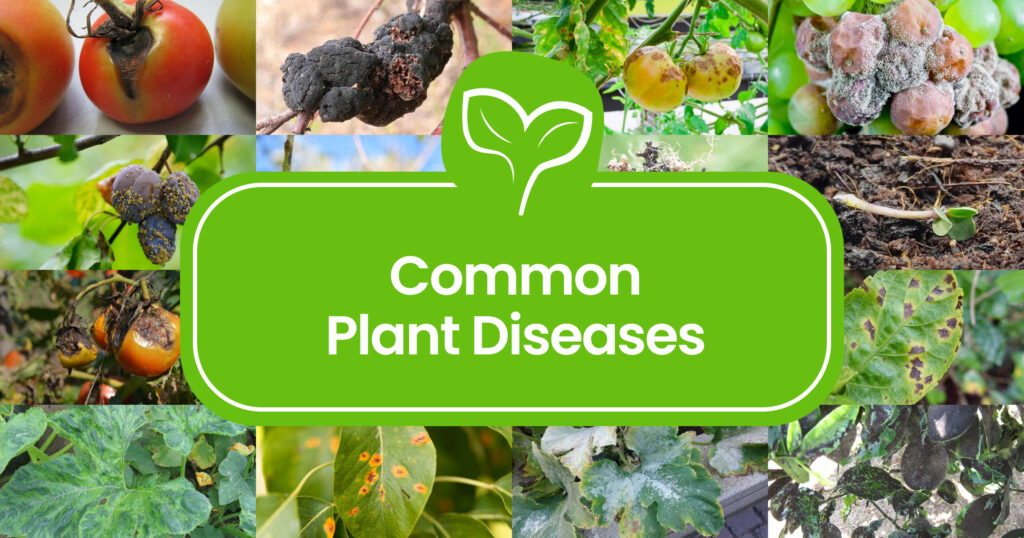
Whether you’re a seasoned gardener or just starting out with your green thumb, understanding the common plant diseases that can wreak havoc on your beloved plants is essential. From pesky powdery mildew to destructive root rot, this article dives deep into the 16 most prevalent plant diseases, equipping you with the knowledge and tools to identify, prevent, and manage them effectively.
We’ll provide you with practical insights and actionable tips, empowering you to protect your plants, maintain a flourishing garden, and minimize the impact of these troublesome diseases. Get ready to arm yourself with invaluable information and bid farewell to plant diseases’ unwelcome presence.
The common causes
In the world of gardening and horticulture, there exists a formidable lineup of plant diseases that can turn a vibrant garden into a battle zone. From powdery mildew to root rot, let’s embark on a journey to define and explore the 16 most common plant diseases that gardeners and plant enthusiasts frequently encounter.
First, let’s take a look at what could contribute to the occurrence of these diseases.
Environmental Factors
Adverse environmental conditions such as excessive humidity, high temperatures, prolonged moisture, or poor air circulation can create favorable conditions for the development and spread of plant diseases. As you probably know already, it is never a good idea to overwater your plants.
Fungal and Bacterial Pathogens
Fungi and bacteria are common culprits behind many plant diseases. These pathogens can be present in the soil, air, or on infected plant debris, and they spread through water, wind, insects, or human activities.
Viral Infections
Viruses are microscopic organisms that invade plant cells and disrupt their normal functioning. They are often transmitted through insect vectors, such as aphids or leafhoppers, or via infected plant material.
Poor Plant Hygiene
Neglecting basic plant hygiene practices, such as not sanitizing tools, reusing infected soil, or failing to remove and dispose of diseased plant debris, can lead to the introduction and spread of diseases in a garden or crop.
Weak or Stressed Plants
Plants that are weak or under stress due to inadequate nutrition, improper watering, or other factors are more susceptible to diseases. When plants are weakened, their natural defense mechanisms become compromised, making them easier targets for pathogens.
Most common Plant Diseases
Powdery Mildew
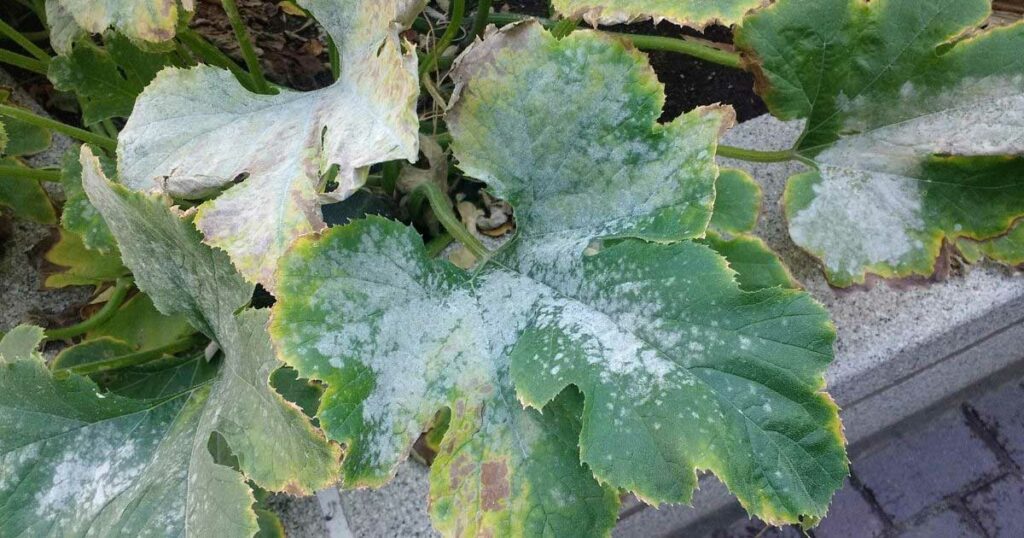
Powdery mildew, a common fungal disease, can be a bane for gardeners and plant enthusiasts. It can affect many plants in your garden, including apples, gooseberries, grapes, cucumbers, peas, rhododendrons, or even English oak. Recognizing its signs and symptoms early on is crucial for effective management.
| Signs: | Powdery mildew manifests as a powdery, white or grayish coating on the leaves, stems, and sometimes even flowers of plants. The affected plant parts may appear as if they have been dusted with talcum powder. As the infection progresses, the powdery patches may spread, covering larger areas of the plant. In severe cases, leaves may curl, distort, or even drop prematurely. While powdery mildew affects a wide range of plants, it is particularly common on roses, cucumbers, squash, and other members of the Cucurbitaceae family. |
| Causes: | Several factors create favorable conditions for powdery mildew’s development. These include: – moderate temperatures (around 60-80°F) – high humidity – poor air circulation – overcrowding of plants The disease thrives in environments where there are extended periods of leaf wetness or relative humidity above 50%. Shaded areas, dense canopies, and a lack of sunlight can also contribute to its spread. |
| Prevention: | Prevention is key when it comes to managing powdery mildew. Here are some strategies to consider: Choose Resistant Varieties: Opt for plant varieties that are known for their resistance to powdery mildew. This can significantly reduce the likelihood of infection. Promote Air Circulation: Ensure proper spacing between plants to allow for good air circulation, as this helps prevent the buildup of humidity and discourages powdery mildew growth. Water at the Base: Watering plants at the base rather than from above helps keep the foliage dry and minimizes conditions conducive to powdery mildew. Monitor Humidity: Regularly monitor and manage humidity levels in the garden. If the environment becomes excessively humid, consider using fans or opening up the area to improve air movement. Remove Infected Plant Material: Promptly remove and destroy any infected plant material to prevent the spread of spores. Avoid composting infected debris. Apply Preventive Treatments: In high-risk situations, such as when growing susceptible plants or in areas prone to powdery mildew outbreaks, you can apply preventive fungicidal treatments according to label instructions. |
Hot tip for controlling Powdery Mildew: When used alone, baking soda is ineffective in combating powdery mildew, but when combined with liquid soap and water, it becomes a reliable preventative measure. However, its effectiveness diminishes once the plant is already infected with the fungus. To manage powdery mildew, create a mixture of baking soda, liquid soap, and water, and apply it by spraying the plant, ensuring complete coverage. Prior to full application, test a small area and refrain from treating stressed plants or using in hot weather.
Rust
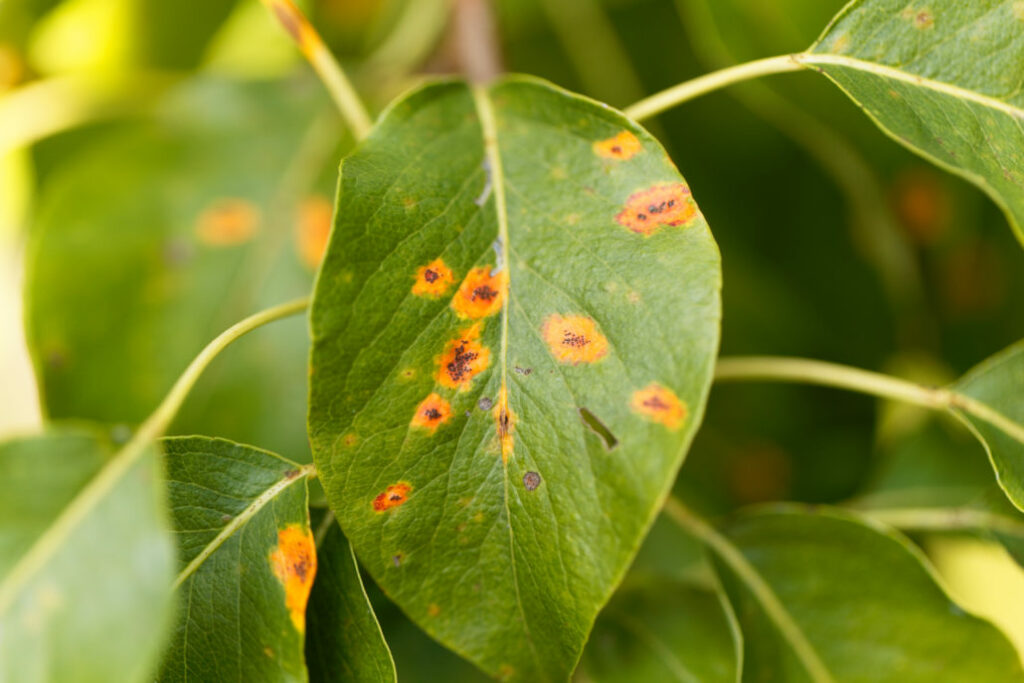
Rust, a common plant disease caused by various fungal pathogens, can wreak havoc on your garden’s foliage. It can affect shrubs, trees, herbs, grasses, fruits, and vegetables like tomatoes also. Just like with many other diseases, being able to identify the signs and symptoms early on is essential.
| Signs: | Rust manifests as small, raised pustules on the undersides of leaves, appearing as powdery or rusty-colored spots. As the infection progresses, these spots can enlarge, turn brown or orange, and develop a rough texture. The affected leaves may exhibit yellowing, wilting, and premature defoliation. Rust is often seen on plants such as roses, hollyhocks, beans, and various ornamentals. |
| Causes: | Rust thrives under specific conditions. Warm temperatures (around 60-80°F), high humidity, and prolonged leaf wetness are favorable for its development. Overcrowded plantings, poor air circulation, and excessive shade can also contribute to the spread of rust. Additionally, the disease can overwinter on infected plant debris or alternate hosts, reemerging in the following growing season. |
| Prevention: |
Plant Resistant Varieties: Select rust-resistant plant varieties whenever possible. These varieties are specifically bred to have increased resistance to the disease, minimizing its impact. Adequate Spacing: Ensure proper spacing between plants to promote air circulation and reduce humidity levels, as this hampers rust’s ability to thrive and spread. Water at the Base: Water plants at the base to keep foliage dry, discouraging rust spore germination and minimizing disease progression. Remove Infected Leaves: Promptly remove and destroy any leaves or plant material showing signs of rust. This helps prevent the disease from spreading to healthy parts of the plant and other nearby plants. Clean Garden Tools: Rust spores can cling to garden tools and be transferred to healthy plants. Regularly clean and disinfect tools to minimize the risk of spreading the disease. Apply Fungicides: In severe cases or when preventative measures are insufficient, consider applying fungicides labeled for rust control. Follow the instructions carefully and apply them at the appropriate times. |
Hot tip for controlling Rust: Various fungicides – like this one – that you can apply using a spray, including Mancozeb for protection and myclobutanil for eradication, are generally effective against all types of rust.
Botrytis cinerea
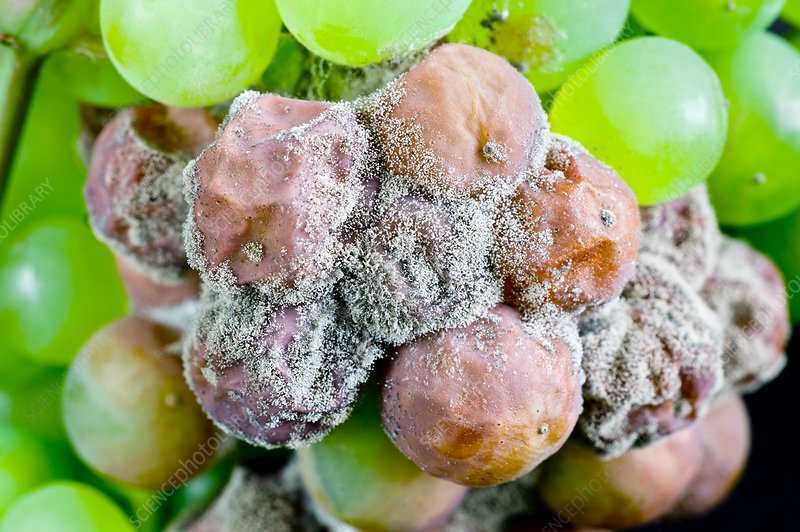
Botrytis cinerea, commonly known as gray mold, is a notorious fungal disease that can wreak havoc on a wide range of plants. You can identify this disease pretty quickly if your plant (tomatoes are especially vulnerable to this) starts to turn gray at the stem.
| Signs: | Botrytis cinerea often appears as a fuzzy, grayish mold on the affected plant parts. It primarily targets flowers, buds, and decaying plant matter, but it can also infect leaves, stems, and fruits. The affected plant tissues may exhibit water-soaked spots, which later turn brown or gray. As the infection progresses, the mold expands, causing rapid decay, shriveling, and a musty odor. Botrytis cinerea is commonly found on roses, strawberries, grapes, and a variety of ornamental plants. |
| Causes: | Botrytis cinerea thrives in cool and humid conditions, typically ranging from 59-77°F, with high relative humidity. Excessive moisture, poor air circulation, and overcrowding of plants provide an ideal environment for its development. Damaged or senescent plant tissues, along with organic debris, serve as a nutrient source and can facilitate the spread of the disease. |
| Prevention: |
Improve Air Circulation: Ensure adequate spacing between plants to promote air circulation, reducing humidity levels and preventing prolonged leaf wetness. Water Management: Water plants at the base and avoid overhead irrigation, as damp foliage provides a conducive environment for the disease. Water in the early morning, allowing leaves to dry before nighttime. Remove Infected Plant Material: Promptly remove and dispose of any infected plant parts, including flowers, buds, and decaying plant matter. This eliminates potential sources of spores and limits the spread of the disease. Pruning and Sanitizing: Prune and remove dead or damaged plant material to improve airflow and eliminate potential infection sites. Clean and sanitize pruning tools to prevent the transfer of spores between plants. Monitor and Maintain Plant Health: Regularly inspect plants for signs of stress or damage, and promptly address any issues. Healthy plants are better equipped to resist and recover from Botrytis cinerea infections. Fungicidal Treatments: In severe cases or high-risk situations, consider applying fungicides labeled for Botrytis cinerea control. Follow the instructions and recommendations provided by the product carefully. |
Hot tip for controlling Botrytis cinerea: While you cannot really cure an already infected plant, you can use organic fungicides for prevention. If you already see the signs, make sure to remove the infected parts first!
Late blight
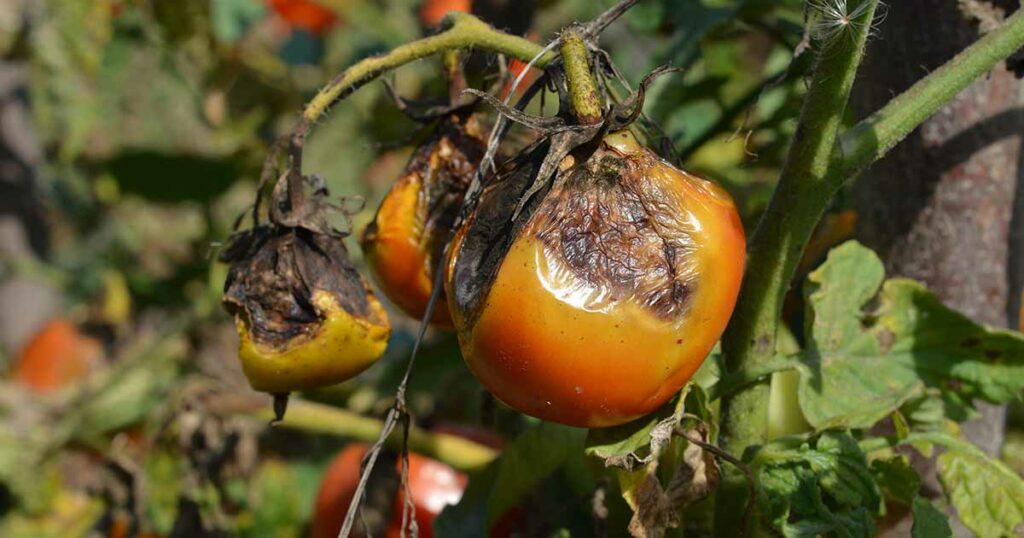
Late blight, caused by the fungal-like pathogen Phytophthora infestans, is a destructive disease that affects tomatoes and potatoes. Recognizing its signs and symptoms early on is crucial for prompt intervention
| Signs: | Late blight initially appears as dark, water-soaked lesions on the leaves, stems, and fruits of affected plants. These lesions rapidly enlarge and turn brown or black. Under favorable conditions, a fuzzy white mold may develop on the undersides of leaves, especially during periods of high humidity. Infected tomato fruits exhibit greasy, dark-colored patches that eventually collapse. Late blight can decimate entire plantations if left uncontrolled. |
| Causes: | Late blight thrives in cool and wet conditions, typically between 60-75°F, with high humidity or extended periods of leaf wetness. It spreads rapidly through wind-dispersed spores and can survive on infected plant debris. Overcrowding, poor air circulation, and excessive nitrogen fertilization can create an environment conducive to late blight development and spread. |
| Prevention: |
Choose Resistant Varieties: Opt for tomato and potato varieties that are resistant or tolerant to late blight, like the Legend Tomato, or the Setanta potato. This can significantly reduce the risk of infection. Proper Plant Spacing: Provide adequate spacing between plants to promote airflow and reduce humidity levels, which inhibits the spread of late blight. Monitor Weather Conditions: Stay informed about local weather forecasts, especially regarding temperature and humidity. Take preventive action when conditions become favorable for late blight development. Practice Crop Rotation: Rotate tomato and potato crops with unrelated plants each year to disrupt the disease’s life cycle and reduce the buildup of inoculum in the soil. Maintain Plant Health: Ensure plants receive proper nutrition, avoid excessive nitrogen fertilization, and promptly address any signs of stress or disease. Healthy plants are more resilient to late blight. Timely Harvesting and Removal of Infected Material: Harvest ripe fruits promptly and remove any infected plant material from the garden. Dispose of infected debris away from the growing area to prevent further contamination. Fungicidal Treatments: In high-risk situations, such as during periods of prolonged wet weather, apply fungicides labeled for late blight control. Follow the instructions and recommended application schedules to maximize effectiveness. |
Hot tip for controlling Late Blight: regularly apply a copper-based fungicide (2 oz/gallon of water) every week or sooner, especially after heavy rainfall or when the disease is rapidly spreading.
Canker
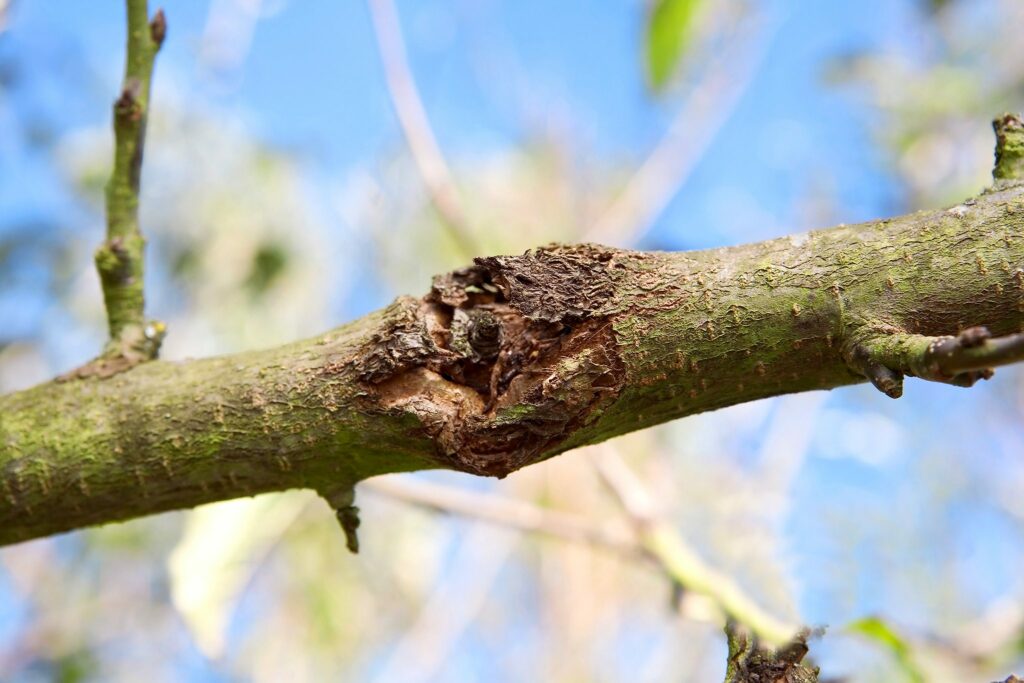
Canker, a widespread plant disease caused by various fungi and bacteria, can simply devastate trees, shrubs, and woody plants. Recognizing the signs and symptoms early on is crucial for effective management. Here’s what you should know:
| Signs: | Canker appears as localized areas of dead or discolored bark on branches, trunks, or stems. These areas may exhibit sunken or swollen patches and can vary in size and shape. As the disease progresses, cankers may enlarge, causing girdling and eventually leading to branch dieback or plant decline. Splitting or oozing of sap from cankered areas may also occur. It is important to note that canker symptoms can vary depending on the host plant and the specific causal agent involved. |
| Causes: | Canker pathogens can enter plants through wounds, pruning cuts, or natural openings, such as lenticels. Stress factors like drought, frost damage, insect infestations, or other injuries weaken plants and make them more susceptible to canker development. Additionally, certain environmental conditions, such as prolonged periods of moisture or high humidity, can favor the spread and establishment of canker-causing pathogens. |
| Prevention: |
Prune Properly: Practice correct pruning techniques, ensuring clean cuts and avoiding unnecessary wounds. Make pruning cuts just outside the branch collar, as this promotes proper healing and reduces the risk of pathogen entry. Maintain Plant Health: Provide optimal growing conditions, including regular watering, balanced nutrition, and appropriate spacing to minimize stress on plants. Healthy, vigorous plants are more resistant to canker. Sanitize Pruning Tools: Disinfect pruning tools with a solution of 70% isopropyl alcohol or a household bleach solution between cuts and between plants to prevent the spread of canker-causing pathogens. Monitor and Remove Infected Plant Material: Regularly inspect plants for canker symptoms and promptly remove and destroy infected branches or plant parts. Prune back to healthy tissue, at least 4-6 inches beyond the visible symptoms. Maintain Good Air Circulation: Properly space plants to allow for good air movement and reduce humidity levels around the foliage. This discourages the development and spread of canker-causing pathogens. Apply Fungicidal or Bactericidal Treatments: In severe cases or high-risk situations, consider applying appropriate fungicides or bactericides labeled for canker control. Follow the instructions and recommended application schedules provided by the product. |
Hot tip for controlling Canker: To address canker on plums and cherries, apply a copper fungicide (with copper oxychloride) thrice annually: in mid-August, mid-September, and mid-October.
Give it a read

Alternaria solani (Early Blight)
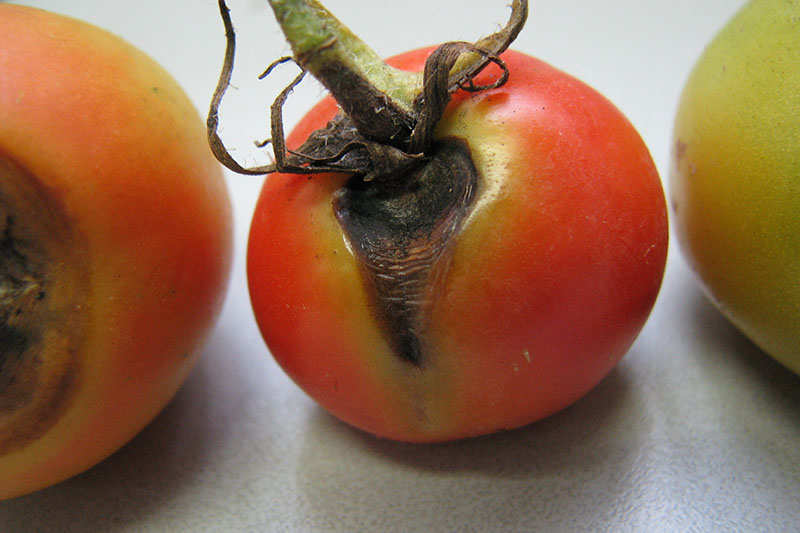
Commonly known as early blight, is a fungal disease that affects a wide range of plants, especially (just like Late Blight) tomatoes and potatoes. Recognizing the signs and symptoms early on is crucial for effective management.
| Signs: | Early blight manifests as circular or irregular-shaped lesions on the leaves, starting from the lower parts of the plant and progressing upward. These lesions exhibit concentric rings, with a characteristic “bullseye” appearance. As the disease advances, the spots may enlarge and develop a dark brown or black color. Infected leaves may also exhibit yellowing, wilting, and premature defoliation. Early blight can affect both foliage and fruits, causing significant yield loss if left uncontrolled. |
| Causes: | Early blight thrives in warm and humid conditions, typically ranging from 75-85°F, with moderate moisture. The pathogen can overwinter in infected plant debris, soil, or seed, and spreads through splashing water, wind, or contact. Overhead irrigation, poor air circulation, crowded plantings, and excessive nitrogen fertilization can create an environment favorable for early blight development and spread. |
| Prevention: |
Plant Resistant Varieties: Opt for tomato and potato varieties that are resistant or tolerant to early blight. These varieties have increased resistance to the disease, reducing its impact. Proper Plant Spacing: Provide adequate spacing between plants to promote airflow and reduce humidity levels, inhibiting the spread of early blight. Prune lower leaves to increase air circulation. Water at the Base: Water plants at the base, preferably using drip irrigation or soaker hoses. Avoid overhead watering, as it can splash spores onto the foliage and facilitate disease spread. Mulch and Weed Control: Apply organic mulch around the base of plants to prevent soil splashing onto the leaves. Maintain weed-free surroundings to reduce competition and improve air circulation. Sanitation Practices: Remove and destroy any infected plant debris to prevent the overwintering and spread of the pathogen. Clean gardening tools and equipment to avoid cross-contamination. Fungicidal Treatments: In severe cases or when preventive measures are insufficient, consider applying fungicides labeled for early blight control. Follow the instructions and recommended application schedules. |
Hot tip to control Alternaria solani (Early Blight): administer copper-based fungicides in advance, around two weeks prior to the expected disease onset or during prolonged wet weather as predicted by forecasts. Alternatively, commence treatment upon initial disease signs and repeat every 7-10 days until the issue is resolved.
Leaf Spot
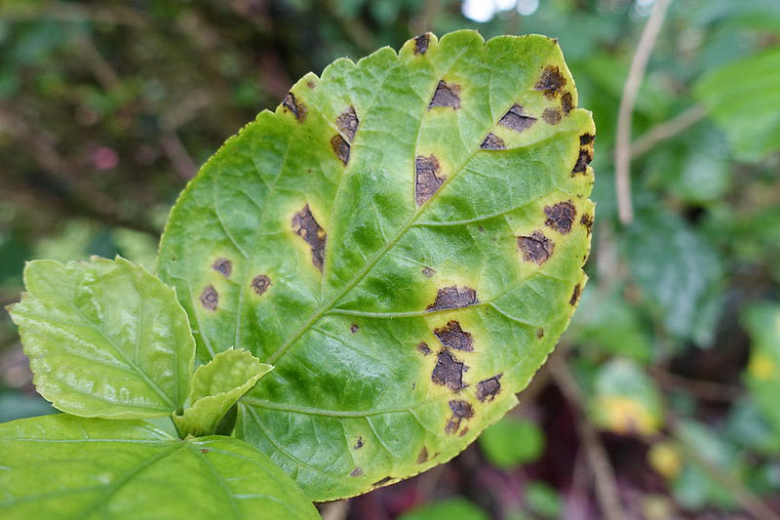
Leaf spot is a prevalent plant disease caused by various fungal pathogens, impacting a wide range of plants, including ornamentals, vegetables, and fruit trees.
| Signs: | Leaf spot typically appears as circular or irregular-shaped spots on the leaves, ranging in size and color depending on the specific pathogen involved. The spots may be dark brown, black, red, or yellow and may have distinct margins. In some cases, the spots can coalesce, causing large areas of leaf damage. As the disease progresses, the spots may exhibit characteristic fruiting structures, such as fungal spore-producing structures, on the leaf surface. Severe infections can lead to defoliation and reduced plant vigor. |
| Causes: | Leaf spot pathogens thrive in warm and humid conditions, where moisture lingers on foliage. Overhead irrigation, rain, and high humidity can create a favorable environment for disease development and spread. Additionally, factors like overcrowding, poor air circulation, extended leaf wetness, and nutrient imbalances can weaken plants and make them more susceptible to leaf spot infections. |
| Prevention: |
Monitor and Inspect: Regularly inspect plants for signs of leaf spot, especially during periods of high humidity or after rainfall. Early detection allows for prompt intervention. Water at the Base: Avoid overhead watering and wetting the foliage. Instead, water plants at the base, directing the water to the root zone. This helps minimize leaf wetness and reduces the risk of infection. Maintain Plant Spacing: Provide adequate spacing between plants to improve air circulation and reduce humidity levels, discouraging leaf spot development. Prune for Airflow: Prune and thin out dense foliage to promote airflow and reduce moisture accumulation. This helps keep the foliage dry and creates an unfavorable environment for pathogens. Clean Garden Debris: Remove fallen leaves, plant debris, and infected material from the garden. Properly dispose of or compost the debris away from the growing area to prevent the spread of pathogens. Practice Crop Rotation: Rotate susceptible plants to different locations each year to break the disease cycle and reduce pathogen buildup in the soil. Fungicidal Treatments: In severe cases or when preventive measures are insufficient, consider applying fungicides labeled for leaf spot control. Follow the instructions and recommended application schedules provided by the product. |
Hot tip for controlling Leaf Spot: Once you spot the disease, use sulfur sprays or copper-based fungicides on a weekly basis to stop the spreading. While these organic fungicides do not eradicate leaf spot, they effectively impede spore germination.
Damping off
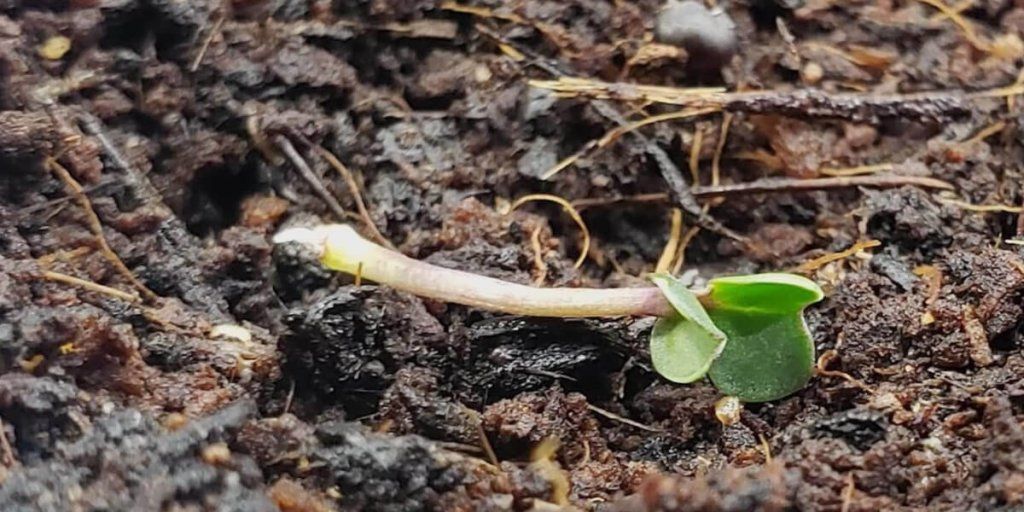
Damping off is a common plant disease that primarily affects seedlings, causing devastating losses in nurseries, greenhouses, and home gardens. Recognizing the signs and symptoms early on is crucial for effective management.
| Signs: | Damping off typically manifests as sudden seedling death or stunted growth. There are two common forms: pre-emergence damping off, which occurs before the seedlings emerge from the soil, and post-emergence damping off, which affects emerged seedlings. In pre-emergence damping off, the seeds may rot, preventing germination. In post-emergence damping off, the seedlings may exhibit water-soaked stems, wilting, and a soft, darkened base. Infected seedlings may eventually collapse and die. White fungal growth may be visible on the affected plant parts in humid conditions. |
| Causes: | Several factors contribute to the development and spread of damping off. Overly moist or poorly drained soil creates a favorable environment for disease-causing pathogens, which include various fungi and sometimes bacteria. High humidity, overcrowded seedlings, and lack of airflow exacerbate the problem. Damping off is often more prevalent in cool and wet conditions, making early spring and early fall, particularly vulnerable periods. |
| Prevention: |
Use Clean Soil and Sterilized Containers: Start with a high-quality, sterile seed-starting mix and clean containers to reduce the presence of disease-causing organisms. Proper Watering: Avoid overwatering, as excessive soil moisture contributes to damping off. Water the seedlings from below or use a misting system to keep the foliage dry. Good Drainage: Ensure proper drainage in containers or seedling trays to prevent waterlogging and create a healthy root environment. Adequate Air Circulation: Provide good air circulation by using fans or opening windows and vents in greenhouses. This helps reduce humidity and minimizes the chances of fungal growth. Thin Seedlings: Thin out overcrowded seedlings to reduce competition for resources and improve airflow around the plants. Improve Growing Conditions: Maintain optimal temperature and humidity levels for seedling growth. Use heating mats, if necessary, to provide bottom warmth and discourage fungal activity. Sanitation Practices: Clean and disinfect seedling trays, pots, and tools before each use to minimize the spread of pathogens. Seed Treatment: Consider treating seeds with a fungicidal seed treatment before sowing. This can help protect them from damping off pathogens. |
Hot tip for controlling Damping Off: the best thing you can do against this is to prevent it by sanitizing your gardening tools freequently.
Black Knot
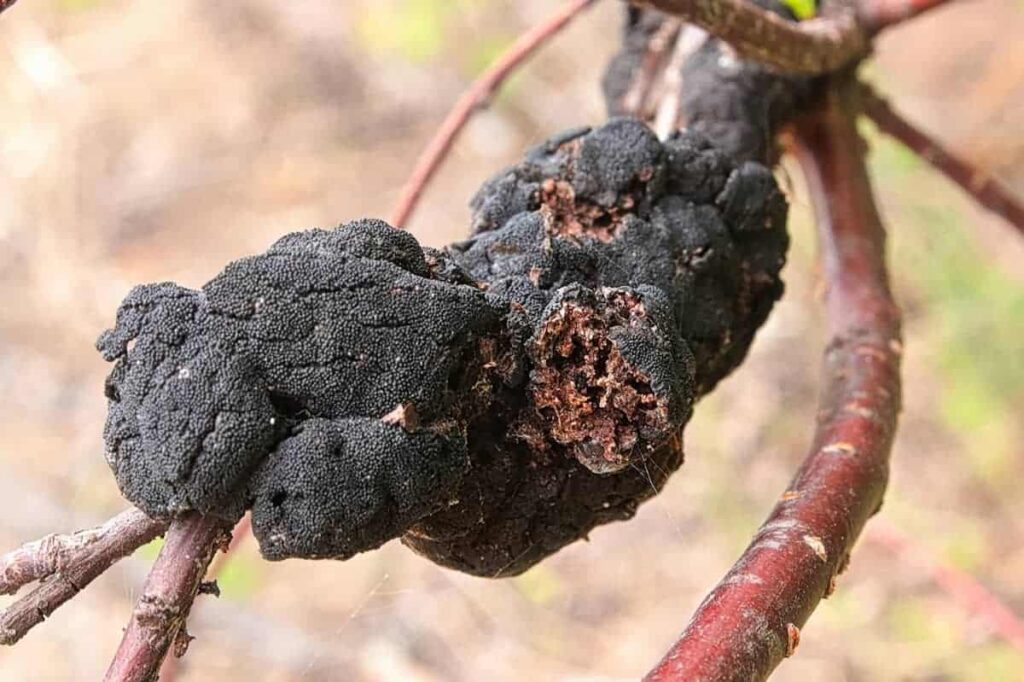
Black knot is a destructive fungal disease that primarily affects Prunus species, including cherry, plum, and other stone fruit trees. If you catch it early, there is a chance you can control it.
| Signs: | Black knot appears as distinctive, rough, and blackened swellings or galls on the branches, twigs, and sometimes the fruit of infected trees. These galls can vary in size from a few inches to several feet and have a hard, woody texture In the early stages, the galls may be green or olive-colored, but they turn black as the disease progresses. Over time, the galls expand and can girdle the branches, leading to dieback and eventual tree decline. |
| Causes: | The fungal pathogen, Apiosporina morbosa, causes black knot. It spreads through spores released from the galls during wet spring weather, allowing the disease to infect healthy branches and trees. Factors that contribute to the development and spread of black knot include overhead irrigation, poor air circulation, dense tree canopies, and wounds or pruning cuts that provide entry points for the pathogen. |
| Prevention: |
Prune and Destroy Infected Branches: Prune and remove infected branches at least 4-6 inches below the visible galls, making cuts in healthy wood. Burn or dispose of the infected branches away from the garden to prevent spore spread. Prune During Dormancy: Conduct pruning during the dormant season (late winter to early spring) when the disease is less active. Avoid pruning during wet periods to minimize the risk of spreading spores. Improve Air Circulation: Prune trees to improve air circulation and reduce humidity within the canopy. This helps to inhibit fungal growth and spread. Monitor and Remove Wild Hosts: Identify and remove any wild Prunus trees or other susceptible hosts in the vicinity, as they can serve as sources of infection. Fungicidal Treatments: In severe cases or when prevention measures are insufficient, consider applying fungicides labeled for black knot control. Follow the instructions and recommended application schedules provided by the product. Regular Tree Inspections: Regularly inspect your trees for early signs of black knot. Be vigilant in identifying and removing any galls or infected branches promptly. |
Hot tip for controlling Black Knot: Remove knots during winter when spore production is low. Cut well beyond galls (about 4-8 inches) to remove all infections and spores. For larger branches, remove them entirely. Use a pruning knife or shear to cut galls on trunks and branches, extending at least an inch beyond the infection.
Clubroot
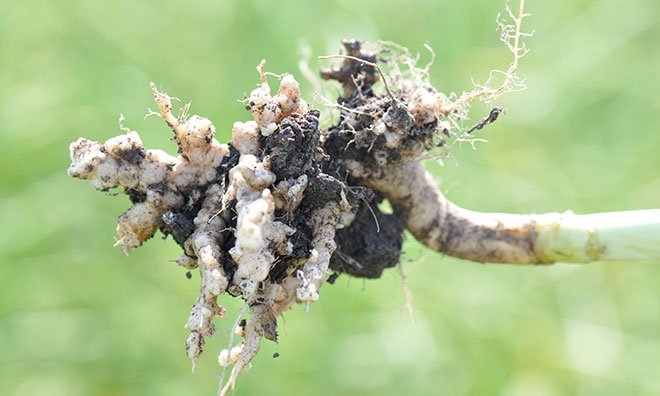
Clubroot is a serious soil-borne disease that affects cruciferous vegetables, including cabbage, broccoli, cauliflower, and radishes. As in many other cases, early detection of this disease is crucial for effective management.
| Signs: | Clubroot primarily affects the roots of infected plants, causing them to become swollen, distorted, and club-like in appearance. Initially, the symptoms may be subtle, with slight swelling or thickening of the roots. As the disease progresses, the affected roots can become significantly enlarged, sometimes reaching several times their normal size. Infected plants may exhibit stunted growth, wilting, yellowing of leaves, and overall decline. In severe cases, the roots may disintegrate, leading to plant death. |
| Causes: | The soil-borne pathogen Plasmodiophora brassicae causes clubroot. It can survive in the soil for many years, making it a persistent threat. Several factors contribute to the development and spread of clubroot, including acidic soil conditions, poor drainage, and the presence of susceptible host plants. The pathogen enters the roots through wounds or natural openings and establishes itself, resulting in the characteristic club-like root symptoms. |
| Prevention: |
Crop Rotation: Practice a minimum three-year crop rotation, avoiding planting cruciferous vegetables in the same area more frequently. This helps to break the disease cycle and reduce pathogen build-up in the soil. Soil pH and Drainage: Maintain proper soil pH around neutral (pH 6.5-7.5) and ensure good soil drainage. Clubroot thrives in acidic soil conditions, so adding lime or other soil amendments can help raise the pH and create an unfavorable environment for the pathogen. Resistant Varieties: Choose and plant clubroot-resistant vegetable varieties whenever possible. These varieties have been bred to tolerate or suppress the disease and can help mitigate its impact. Soil Sterilization: Consider solarization or soil sterilization techniques for small areas or container gardening. This can help eliminate the clubroot pathogen from the soil. Sanitation Practices: Clean and disinfect tools, equipment, and containers to prevent the spread of the disease between plants or garden areas. Remove and destroy any infected plant debris to reduce the source of infection. Prevent Contaminated Soil Movement: Minimize the transfer of soil from infected areas to healthy areas, as the pathogen can be carried on tools, shoes, or contaminated soil. |
Hot tip for Controling Clubroot: Managing clubroot is very challenging, but crop rotation, avoiding planting cruciferous plants in the same area for more than three to four years is the most effective way to control its spread. Also, increasing the soil’s pH to at least 7.2, and using calcitic lime is the best option unless the soil is deficient in magnesium, in which case dolomitic lime may be more suitable.
Brown rot
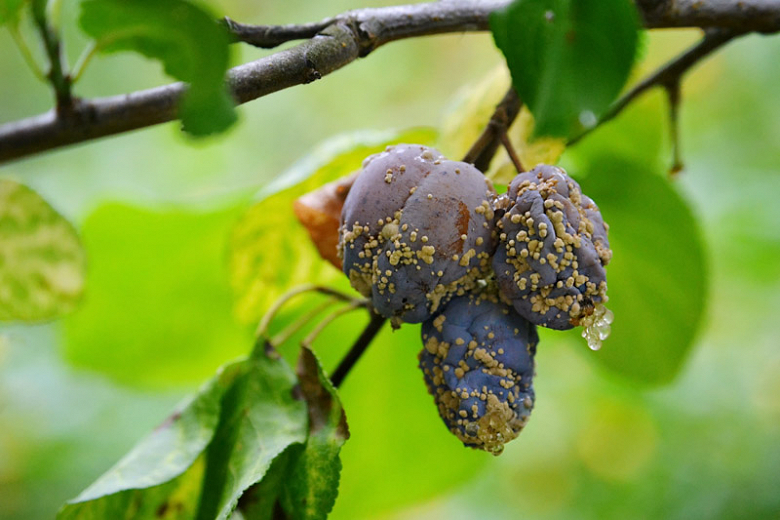
Brown rot is a destructive fungal disease that targets a variety of stone fruit trees, including peaches, plums, cherries, and apricots. Early detection is crucial for effective management, as brown rot can rapidly ruin your tasty fruit crops.
| Signs: | Brown rot typically affects the fruit, causing browning, shriveling, and rotting. Initially, small circular spots appear on the fruit, often surrounded by a concentric ring. As the disease progresses, the spots enlarge, becoming tan or brown in color, with a velvety or fuzzy texture. Infected fruit may mummify, becoming shriveled and dry. In humid conditions, a fuzzy mass of tan to brown spores may develop on the surface of the infected fruit. |
| Causes: | The fungal pathogen Monilinia spp. causes brown rot. It thrives in warm, humid environments and spreads through spores released from infected fruit or plant debris. Factors that contribute to the development and spread of brown rot include high humidity, rain or overhead irrigation during flowering and fruit development, poor air circulation, and wounds or injuries to fruit, which serve as entry points for the fungus. |
| Prevention: |
Sanitation Practices: Remove and destroy any infected fruit, mummified fruit, or plant debris from the orchard or garden area. This helps reduce the source of spores and prevents the disease from spreading. Prune for Airflow: Prune trees to improve air circulation within the canopy, which reduces humidity and creates a less favorable environment for brown rot. Prune out dead or diseased wood and thin out branches to allow better sunlight penetration. Proper Watering: Water the trees at ground level, avoiding overhead irrigation that wets the fruit and foliage. Watering in the morning allows the foliage to dry quickly, reducing the risk of infection. Fungicidal Treatments: Apply appropriate fungicides during critical periods of fruit development and as recommended by local agricultural extension services. Follow the instructions on the product label for proper application and timing. Harvest Practices: Harvest ripe fruit promptly, removing any infected or rotting fruit from the tree. Handle the harvested fruit with care to minimize injuries that could lead to infection. Orchard Hygiene: Keep the orchard area clean and free from fallen fruit, which can become a source of infection. Regularly prune and remove dead wood to prevent disease spread. |
Hot tip to control Brown Rot: You can use a wettable powder fungicide, a liquid concentrate fungicide, or a natural copper-based fungicide spray or dust. However, it is best to apply the fungicide preventatively, even before any symptoms of brown rot appear, and ensure that the chosen spray is suitable for the specific trees as recommended on the label.
Blight

Blight is a broad term encompassing several plant diseases caused by various pathogens, including fungi and bacteria. It affects a wide range of plants, from vegetables and fruits to ornamental flowers and trees.
| Signs: | Blight typically manifests* as sudden wilting, browning, or discoloration of leaves, stems, and fruits. The affected plant parts may develop dark spots, lesions, or a fuzzy or slimy appearance. In some cases, the disease can progress rapidly, leading to the complete collapse and death of the plant. *The specific symptoms may vary depending on the type of blight and the host plant involved. |
| Causes: | Several factors contribute to the development and spread of blight. Moisture, especially prolonged periods of rain or high humidity, creates favorable conditions for blight pathogens to thrive. Poor air circulation, overcrowding of plants, and wounds or injuries to plant tissue can also facilitate the entry and spread of blight-causing pathogens. Additionally, the presence of infected plant material, such as debris or nearby infected plants, can serve as a source of inoculum. |
| Prevention: |
Plant Selection: Choose blight-resistant varieties when available. These varieties have been bred to withstand or tolerate specific types of blight, reducing the risk of infection. Proper Plant Spacing: Provide adequate spacing between plants to ensure good air circulation and minimize moisture retention. This helps reduce the favorable conditions for blight development. Water Management: Water plants at the base, avoiding overhead irrigation that can splash water onto foliage and promote pathogen spread. Water early in the day to allow foliage to dry quickly. Sanitation Practices: Remove and destroy any infected plant material promptly, including leaves, fruits, and plant debris. This reduces the reservoir of blight-causing pathogens and prevents their spread. Fungicidal Treatments: In severe cases or when prevention measures are insufficient, consider using appropriate fungicides labeled for blight control. Follow the instructions and recommended application schedules provided by the product. Crop Rotation: Practice crop rotation, avoiding planting susceptible species or related plants in the same area successively. This helps disrupt the disease cycle and reduce the build-up of blight pathogens in the soil. |
Hot tip to control Blight: Swiftly remove and dispose of all visibly affected sections as soon as possible, while also considering preventative measures such as early-season or warm, moist conditions spraying with a fungicide containing copper oxychloride for protection against blight and its treatment.
Sooty mold
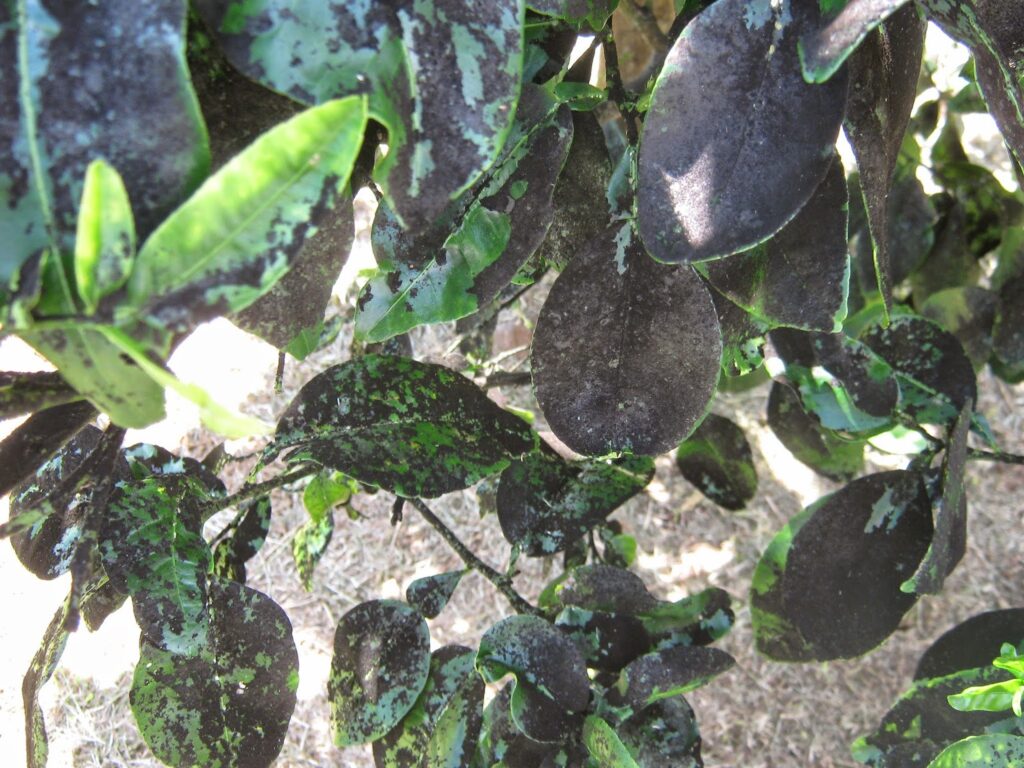
Sooty mold is a common plant problem characterized by a black, powdery coating on the leaves, stems, and sometimes fruits of affected plants. Although it doesn’t directly harm the plant, it can hinder photosynthesis and reduce overall plant vigor.
| Signs: | Sooty mold appears as a black, velvety coating on the surfaces of leaves, stems, and other plant parts. It often grows on the honeydew secreted by sap-sucking insects like aphids, scale insects, and whiteflies. The mold doesn’t infect plant tissue directly but grows on the sticky honeydew, which serves as a nutrient source for the fungus. The black coating can cover large areas, obscuring the plant’s natural color and giving it a dirty, unattractive appearance. |
| Causes: | The development and spread of sooty mold are closely linked to the presence of honeydew-producing insects. These insects feed on plant sap, excreting sugary honeydew that serves as a food source for the mold. High populations of aphids, scale insects, or whiteflies can result in copious amounts of honeydew, creating favorable conditions for sooty mold growth. Environmental factors such as high humidity and warm temperatures also contribute to mold development. |
| Prevention: |
Control Honeydew-Producing Insects: Manage populations of aphids, scale insects, and whiteflies through cultural, mechanical, or biological control methods. This reduces the availability of honeydew and prevents the growth of sooty mold. Pruning and Cleaning: Prune and remove heavily infested plant parts, reducing the potential food source for honeydew-producing insects. Clean the affected plants by gently washing them with a mild soap solution or water to remove the sooty mold. Enhance Air Circulation: Properly space plants and ensure good air circulation to discourage the growth of sooty mold. Prune dense foliage and thin out overcrowded areas to promote better air movement. Insecticidal Treatments: If insect populations are difficult to control through other methods, targeted insecticidal treatments may be necessary. Consult with local agricultural extension services or professionals for appropriate insecticides and application techniques. Encourage Beneficial Insects: Attract natural enemies of honeydew-producing insects, such as ladybugs, lacewings, and parasitic wasps, by providing habitat, food sources, and minimizing pesticide use. These beneficial insects can help keep pest populations in check. |
Hot tip for controlling Sooty Mold: When there are fewer bugs that make sticky stuff called honeydew, there will be less of it and the black mold it causes will go away slowly. It can be hard to get rid of the mold completely, but you can wash it off plants and surfaces by using a strong spray of water or soapy water.
Wilt
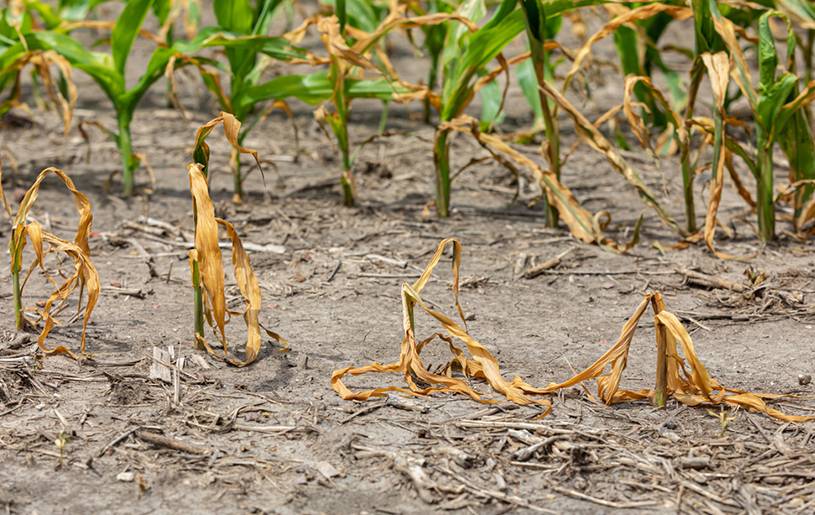
Wilt disease is a common and devastating plant ailment that can affect a wide range of plants, from vegetables and fruits to ornamentals and trees. Wilt pathogens are like parasites that can travel inside trees through their “plumbing” called vascular tissue. These bad organisms can be different types like fungi, worms, germs, etc..
| Signs: | The primary symptom of wilt disease is the wilting and drooping of leaves and stems, even when soil moisture levels are adequate. Initially, the wilting may occur during the hottest part of the day but recover at night. Over time, the wilting becomes persistent and may spread throughout the plant. The leaves may exhibit yellowing, browning, or necrotic patches. In some cases, the plant may show stunted growth or die off completely. |
| Causes: | Wilt disease is often caused by soil-borne pathogens, such as fungi or bacteria, that invade the plant’s vascular system, disrupting the flow of water and nutrients. These pathogens can enter the plant through wounds, natural openings, or root systems. Environmental conditions like excessive soil moisture, poor drainage, high humidity, and warm temperatures create favorable conditions for pathogen growth and spread. |
| Prevention: |
Plant Selection: Choose wilt-resistant or tolerant varieties whenever possible. These varieties have been bred to withstand or tolerate specific pathogens, reducing the risk of infection. Soil Management: Ensure well-draining soil by amending with organic matter and improving soil structure. Avoid overwatering and practice proper irrigation techniques to prevent waterlogging. Crop Rotation: Rotate crops to different areas of the garden each year, especially if you’ve had a history of wilt disease. This helps disrupt the disease cycle and reduces the buildup of pathogens in the soil. Sanitation Practices: Remove and destroy any infected plant material promptly. This includes infected plants, fallen leaves, and debris. Clean gardening tools and equipment to prevent the spread of pathogens. Biological Controls: Consider using beneficial microorganisms or biological agents that suppress wilt-causing pathogens. These can be applied to the soil or used as seed treatments to protect young plants. Proper Plant Care: Maintain overall plant health by providing adequate nutrition, proper watering, and reducing stress factors. Healthy plants are better equipped to resist and recover from diseases. |
Mosaic Virus
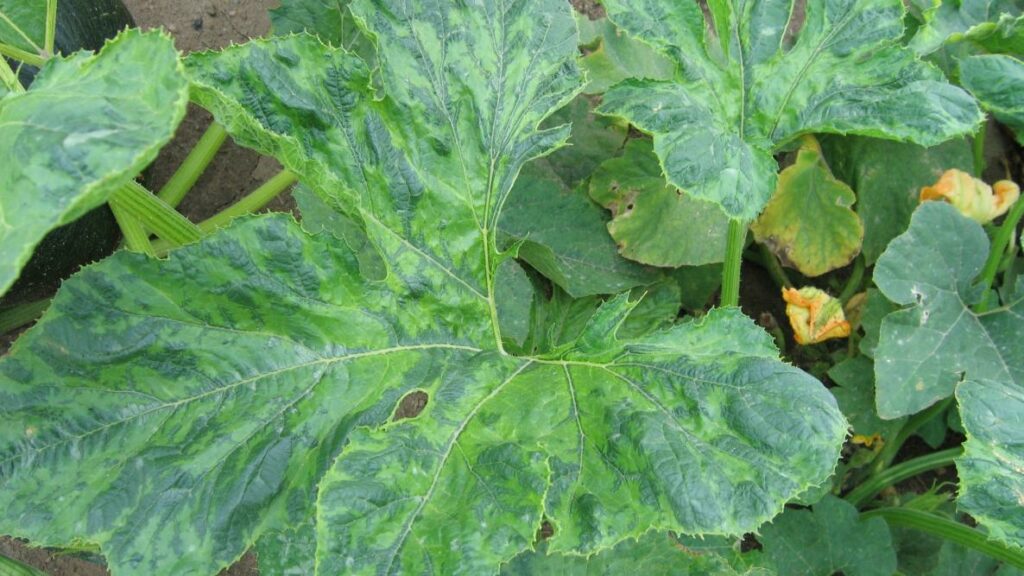
Mosaic virus is a widespread and destructive plant disease that affects numerous crops and ornamental plants. Recognizing the signs and symptoms early on is crucial for preventing its spread and minimizing its impact.
| Signs: | The mosaic virus manifests as a distinctive pattern of mottled or variegated discoloration on the leaves of affected plants. The leaves may display irregular patches, streaks, or rings of lighter or darker colors, giving them a mosaic-like appearance. In addition to the visual cues, other symptoms may include stunted growth, distorted leaves, and reduced yields in fruit-bearing plants. It’s important to note that symptoms can vary depending on the specific plant species and the strain of the virus. |
| Causes: | Mosaic virus is caused by various strains of viruses that can be transmitted through different means. Common modes of transmission include aphids, leafhoppers, whiteflies, contaminated tools, and even infected seeds or plant material. Once a plant is infected, the virus can spread systemically through the vascular tissues, affecting multiple parts of the plant. Factors such as high humidity, warm temperatures, and stressed plants are known to contribute to the development and spread of mosaic virus. |
| Prevention: |
Plant Resistant Varieties: Choose mosaic-resistant plant varieties whenever possible. Resistant varieties have been bred to possess genetic traits that make them less susceptible to the virus. Sanitation Practices: Remove and destroy infected plants promptly to prevent the spread of the virus. Clean gardening tools and equipment thoroughly to prevent contamination. Pest Management: Control the population of aphids, leafhoppers, whiteflies, and other potential vectors of the virus. Use physical barriers, insecticidal sprays, or introduce beneficial insects to keep pest populations in check. Seed and Plant Material Selection: Purchase certified disease-free seeds and plants from reputable sources. Inspect seedlings and young plants for any signs of infection before introducing them into your garden. Weed Control: Eliminate weeds that can serve as reservoirs for the virus. Weeds can harbor the virus and serve as hosts for vectors, facilitating its spread to nearby cultivated plants. Good Cultural Practices: Maintain overall plant health by providing proper nutrition, adequate watering, and optimal growing conditions. Healthy plants are more resilient and less prone to virus infection. |
Hot tip for controlling Mosaic Virus: The best thing you can do here is truly just prevention. Make sure to disinfect all your gardening tools before use. Additionally, to prevent mosaic viruses that come from seeds, you can put the seeds of plants that are easily affected into a mixture of bleach and water (10% bleach solution) before planting them.
Root Rot
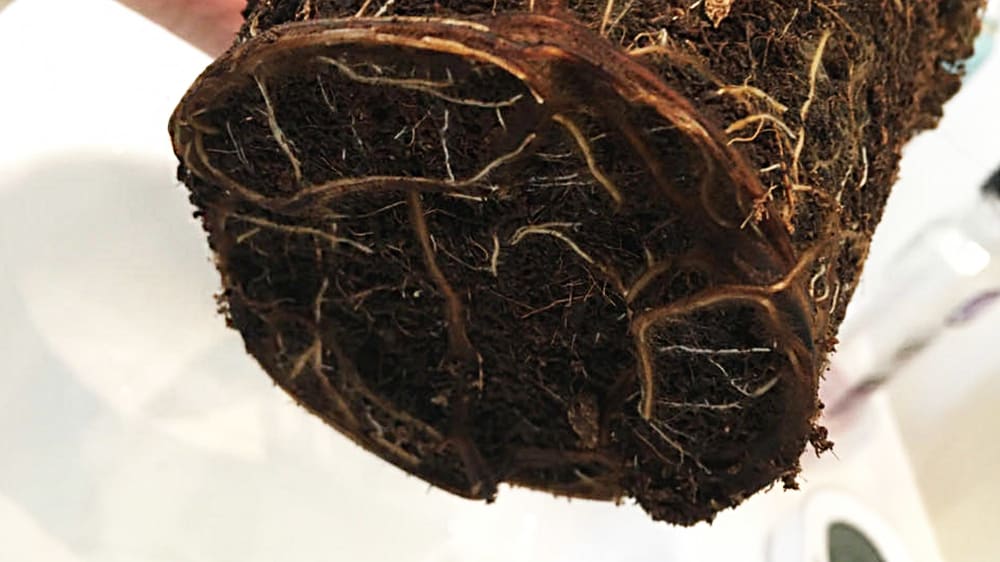
Root rot is a common and destructive plant disease that can silently undermine the health and vitality of your plants. Recognizing the signs and symptoms early on is crucial for effective management
| Signs: | The first visible sign of root rot is often wilting and yellowing of the leaves, which may mimic symptoms of other plant ailments. However, upon closer inspection, you may notice that the roots appear dark, mushy, and waterlogged. Infected plants may exhibit stunted growth, develop an overall decline in health, and easily topple over due to compromised root systems. |
| Causes: | Root rot is typically caused by soil-borne pathogens, such as fungi or bacteria, that thrive in poorly drained soils or excessive moisture conditions. Overwatering, heavy clay soils, compacted soil, and poor drainage contribute to the development and spread of root rot. Furthermore, environmental stressors, such as high temperatures or nutrient imbalances, weaken plants, making them more susceptible to root rot pathogens. |
| Prevention: |
Soil Drainage: Ensure proper soil drainage by amending heavy clay soils with organic matter and creating raised beds or planting mounds. Avoid overwatering and improve soil structure to allow excess water to drain away from the root zone. Watering Practices: Water plants deeply but infrequently, allowing the soil to dry out between waterings. Avoid waterlogging the soil and prevent standing water around the plant’s base. Plant Selection: Choose plant varieties that are tolerant or resistant to root rot pathogens. Research and select cultivars known for their resilience to these diseases. Sanitation: Remove and destroy infected plant material promptly. This includes infected roots, fallen leaves, and debris. Always clean your gardening tools and equipment to prevent the spread of pathogens! Good Cultural Practices: Maintain overall plant health by providing proper nutrition, balanced watering, and adequate sunlight. Avoid over-fertilization, which can stress plants and make them more vulnerable to diseases. Biological Controls: Consider using beneficial microorganisms or biological agents that suppress root rot pathogens. These can be applied as soil drenches or incorporated into the soil to enhance the natural defense mechanisms of plants. |
Hot tip for controlling Root Rot: Look closely at the plant’s roots to make sure they have the problem. Then, wash off the soil, cut off any bad roots, throw away the old soil, clean your tools and pots, and put the plant in new soil that lets water drain well. To stop root rot from happening again, use fresh soil, water the right amount, don’t use too much fertilizer, make sure water can drain from the pot without rocks, and be careful with chemicals unless you’re sure they’re needed.